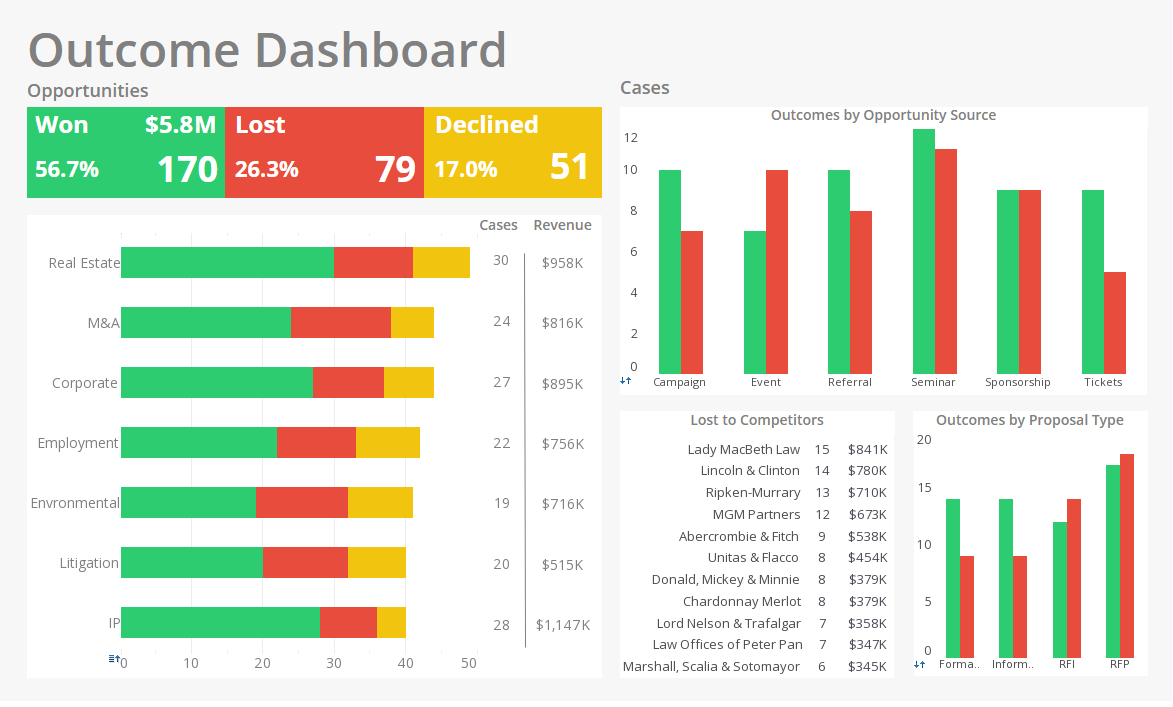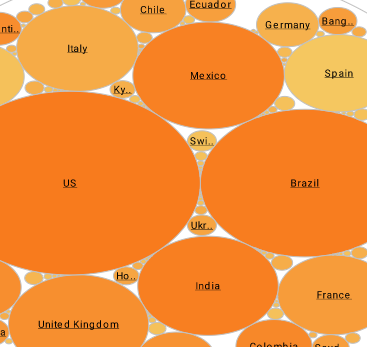Balanced Scorecard Report Creation
InetSoft's reporting software comes equipped with balanced scorecards for reports that can be set up to provide critical up to the minute updates as often as needed. View the information below to learn more about the Style Intelligence solution.
A scorecard is used to keep track of certain parameters (e.g., Sales Revenue). Multiple users can monitor these parameters from the Report Portal. These parameters (metrics) can also be measured at regular intervals (triggers). They can be checked against certain conditions (thresholds, time comparisons, custom business logic etc.) to which they must comply.
If they don't, specified actions can be automatically taken (email notifications, etc.). The metric, trigger, conditions and other settings are collectively handled as a target. A scorecard is thus a collection of one or more targets. Consider the following use of a scorecard: A company aims for a 2% increase in sales revenue every month. A sales manager wishes to closely monitor this metric to ensure a sustained increase in the revenue.
We create a data asset (in the Asset Composer) which calculates the total sales revenue of the company for each month. We create a metric based on the 'Revenue' field of this asset. We optionally associate a detail report with this metric, based on the asset (e.g., a chart plotting the sales revenue on the Y-axis and month on the X-Axis).
| #1 Ranking: Read how InetSoft was rated #1 for user adoption in G2's user survey-based index | Read More |
We set up a target with a trigger to evaluate this metric on a monthly basis. We specify a condition which checks for a 2% increase in revenue in the previous month from the month before. If this condition is not met we can set up notifications to the sales manager, which can be accompanied by the detail report. The sales manager can subscribe to this target and can constantly monitor it from the InetSoft Report Portal. They can also drill down into the metric to view the detail report at any time.
What Does a CPQ Software Solution Track in a Balanced Scorecard?
CPQ (Configure, Price, Quote) software solutions can track a variety of metrics and performance indicators that can be used to create a balanced scorecard for sales and marketing teams. Here are some of the key areas that a CPQ software solution can track:
Customer Acquisition
- New Sales Opportunities Created
- Conversion Rate of Opportunities to Quotes
- Average Lead Cycle Time
- Cost of Customer Acquisition (CAC)
Customer Retention
- Customer Lifetime Value (CLV)
- Customer Satisfaction Scores
- Renewal Rates
- Upsell and Cross-Sell Rates
Product Performance
- Product Revenue
- Product Profitability
- Product Margins
- Average Deal Size
Sales Performance
- Number of Quotes Generated
- Number of Deals Closed
- Win Rate
- Average Deal Cycle Time
- Sales Rep Productivity
Marketing Performance
- Marketing Qualified Leads (MQLs)
- Website Traffic
- Social Media Engagement
- Email Marketing Click-Through Rates
- Return on Marketing Investment (ROMI)
What Does a Spend Management Software Solution Track in a Balanced Scorecard?
A Spend Management Software Solution plays a crucial role in tracking and managing expenses across various categories within an organization. When integrated with a Balanced Scorecard framework, it aligns spending activities with strategic objectives and provides insights into financial performance. Here's how a Spend Management Software Solution can track key metrics within a Balanced Scorecard:
- Financial Perspective:
- Cost Reduction Initiatives: The software can track savings achieved through cost reduction initiatives, such as supplier negotiations, process optimizations, and volume discounts.
- Budget Variance Analysis: It can monitor actual spending against budgeted amounts, highlighting areas of overspending or underspending and facilitating adjustments to stay within budgetary constraints.
- Return on Investment (ROI): By analyzing spending patterns and associated outcomes, the software can calculate the ROI of investments in various projects, initiatives, or procurement activities.
- Customer Perspective:
- Supplier Performance: The software can evaluate supplier performance based on factors such as pricing, quality, delivery timeliness, and responsiveness to customer needs.
- Customer Satisfaction Impact: It can assess the impact of spending decisions on customer satisfaction metrics, such as product/service quality, reliability, and overall experience.
- Internal Business Processes Perspective:
- Procurement Cycle Time: The software can track the time taken to complete the procurement cycle, from requisition to payment, identifying bottlenecks and streamlining processes to improve efficiency.
- Compliance Monitoring: It can monitor compliance with procurement policies, contracts, and regulatory requirements, minimizing risks associated with non-compliance and ensuring transparency and accountability in spending activities.
- Learning and Growth Perspective:
- Employee Training and Development: The software can track spending on employee training and development programs, assessing their impact on employee skills, knowledge, and performance improvement.
- Supplier Relationship Management: It can monitor investments in building and maintaining strong supplier relationships, fostering collaboration, innovation, and mutual value creation.
 |
Learn about the top 10 features of embedded business intelligence. |
What Data Sources Are Mashed Up with Spend Management Data?
In Spend Management, the process of "mashing up" or integrating data from various sources is crucial for gaining comprehensive insights into spending activities and optimizing procurement processes. Here are some common data sources that are typically mashed up with Spend Management data:
-
ERP Systems: Enterprise Resource Planning (ERP) systems serve as a central repository for financial data, including accounts payable, accounts receivable, general ledger, and inventory management. Integrating Spend Management data with ERP systems provides a holistic view of spending across the organization and facilitates accurate financial reporting and analysis.
-
Procurement Systems: Procurement systems manage the end-to-end procurement process, including requisitioning, sourcing, supplier management, and contract management. By integrating data from procurement systems, Spend Management solutions can track purchasing patterns, monitor supplier performance, and enforce compliance with procurement policies and contracts.
-
Supplier Data: Supplier data encompasses information about vendors, suppliers, and third-party service providers, including contact details, financial stability, product/service offerings, and performance metrics. Mashing up Spend Management data with supplier data enables organizations to evaluate supplier relationships, negotiate favorable terms, and mitigate supply chain risks.
-
Expense Management Systems: Expense management systems track employee expenses, travel costs, and other discretionary spending. Integrating data from expense management systems with Spend Management data allows organizations to control and monitor employee spending, enforce expense policies, and identify opportunities for cost savings.
-
Contract Management Systems: Contract management systems centralize contracts, agreements, and legal documents related to procurement activities. By integrating data from contract management systems, Spend Management solutions can ensure compliance with contract terms, track contract milestones and obligations, and optimize contract performance.
-
Market Intelligence Data: Market intelligence data includes information about market trends, pricing benchmarks, competitor activities, and supplier landscapes. Mashing up Spend Management data with market intelligence data enables organizations to benchmark their spending against industry standards, identify cost-saving opportunities, and make informed sourcing decisions.
-
Inventory Management Systems: Inventory management systems track inventory levels, stock movements, and reorder points for raw materials, components, and finished goods. Integrating data from inventory management systems with Spend Management data helps optimize inventory levels, minimize stockouts and excess inventory, and reduce carrying costs.
-
Financial Market Data: Financial market data provides insights into currency exchange rates, interest rates, commodity prices, and other economic indicators that may impact procurement decisions. Mashing up Spend Management data with financial market data helps organizations assess the financial implications of procurement activities and manage currency and commodity risks effectively.
| Previous: Programmatic Report Scheduler Access |



